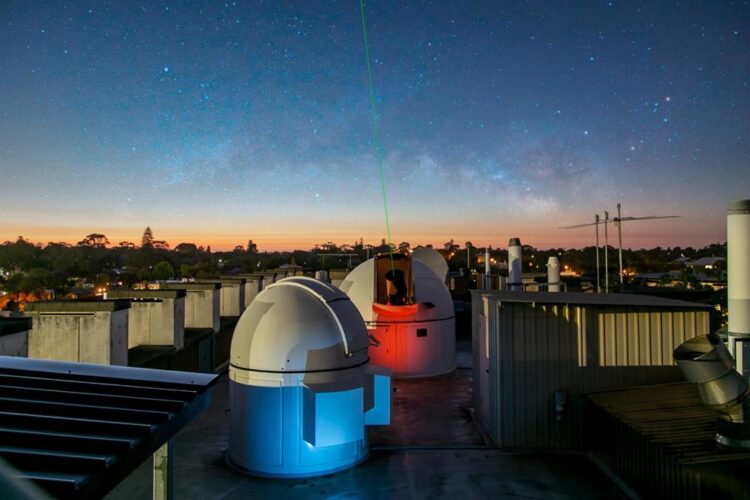Record-breaking laser link could help us test whether Einstein was right

UWA's rooftop observatory.
Credit: ICRAR
Scientists from the International Centre for Radio Astronomy Research (ICRAR) and The University of Western Australia (UWA) have set a world record for the most stable transmission of a laser signal through the atmosphere.
In a study published today in the journal Nature Communications, Australian researchers teamed up with researchers from the French National Centre for Space Studies (CNES) and the French metrology lab Systèmes de Référence Temps-Espace (SYRTE) at Paris Observatory.
The team set the world record for the most stable laser transmission by combining the Aussies’ ‘phase stabilisation’ technology with advanced self-guiding optical terminals.
Together, these technologies allowed laser signals to be sent from one point to another without interference from the atmosphere.
Lead author Benjamin Dix-Matthews, a PhD student at ICRAR and UWA, said the technique effectively eliminates atmospheric turbulence.
“We can correct for atmospheric turbulence in 3D, that is, left-right, up-down and, critically, along the line of flight,” he said.
“It’s as if the moving atmosphere has been removed and doesn’t exist.
“It allows us to send highly-stable laser signals through the atmosphere while retaining the quality of the original signal.”
The result is the world’s most precise method for comparing the flow of time between two separate locations using a laser system transmitted through the atmosphere.
ICRAR-UWA senior researcher Dr Sascha Schediwy said the research has exciting applications.
“If you have one of these optical terminals on the ground and another on a satellite in space, then you can start to explore fundamental physics,” he said.
“Everything from testing Einstein’s theory of general relativity more precisely than ever before, to discovering if fundamental physical constants change over time.”
The technology’s precise measurements also have practical uses in earth science and geophysics.
“For instance, this technology could improve satellite-based studies of how the water table changes over time, or to look for ore deposits underground,” Dr Schediwy said.
There are further potential benefits for optical communications, an emerging field that uses light to carry information.
Optical communications can securely transmit data between satellites and Earth with much higher data rates than current radio communications.
“Our technology could help us increase the data rate from satellites to ground by orders of magnitude,” Dr Schediwy said.
“The next generation of big data-gathering satellites would be able to get critical information to the ground faster.”
The phase stabilisation technology behind the record-breaking link was originally developed to synchronise incoming signals for the Square Kilometre Array telescope.
The multi-billion-dollar telescope is set to be built in Western Australia and South Africa from 2021.
All latest news from the category: Physics and Astronomy
This area deals with the fundamental laws and building blocks of nature and how they interact, the properties and the behavior of matter, and research into space and time and their structures.
innovations-report provides in-depth reports and articles on subjects such as astrophysics, laser technologies, nuclear, quantum, particle and solid-state physics, nanotechnologies, planetary research and findings (Mars, Venus) and developments related to the Hubble Telescope.
Newest articles

Innovative 3D printed scaffolds offer new hope for bone healing
Researchers at the Institute for Bioengineering of Catalonia have developed novel 3D printed PLA-CaP scaffolds that promote blood vessel formation, ensuring better healing and regeneration of bone tissue. Bone is…

The surprising role of gut infection in Alzheimer’s disease
ASU- and Banner Alzheimer’s Institute-led study implicates link between a common virus and the disease, which travels from the gut to the brain and may be a target for antiviral…

Molecular gardening: New enzymes discovered for protein modification pruning
How deubiquitinases USP53 and USP54 cleave long polyubiquitin chains and how the former is linked to liver disease in children. Deubiquitinases (DUBs) are enzymes used by cells to trim protein…


